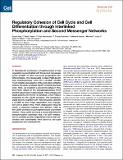| dc.contributor.author | Abel, Sören | |
| dc.contributor.author | Chien, Peter | |
| dc.contributor.author | Wassmann, Paul | |
| dc.contributor.author | Schirmer, Tilman | |
| dc.contributor.author | Kaever, Volkhard | |
| dc.contributor.author | Baker, Tania | |
| dc.contributor.author | Jenal, Urs | |
| dc.contributor.author | Laub, Michael T. | |
| dc.contributor.author | Laub, Michael T | |
| dc.date.accessioned | 2013-12-19T16:44:19Z | |
| dc.date.available | 2013-12-19T16:44:19Z | |
| dc.date.issued | 2011-08 | |
| dc.identifier.issn | 10972765 | |
| dc.identifier.uri | http://hdl.handle.net/1721.1/82942 | |
| dc.description.abstract | In Caulobacter crescentus, phosphorylation of key regulators is coordinated with the second messenger cyclic di-GMP to drive cell-cycle progression and differentiation. The diguanylate cyclase PleD directs pole morphogenesis, while the c-di-GMP effector PopA initiates degradation of the replication inhibitor CtrA by the AAA+ protease ClpXP to license S phase entry. Here, we establish a direct link between PleD and PopA reliant on the phosphodiesterase PdeA and the diguanylate cyclase DgcB. PdeA antagonizes DgcB activity until the G1-S transition, when PdeA is degraded by the ClpXP protease. The unopposed DgcB activity, together with PleD activation, upshifts c-di-GMP to drive PopA-dependent CtrA degradation and S phase entry. PdeA degradation requires CpdR, a response regulator that delivers PdeA to the ClpXP protease in a phosphorylation-dependent manner. Thus, CpdR serves as a crucial link between phosphorylation pathways and c-di-GMP metabolism to mediate protein degradation events that irreversibly and coordinately drive bacterial cell-cycle progression and development. | en_US |
| dc.description.sponsorship | Swiss National Science Foundation (grant 31-108186) | en_US |
| dc.description.sponsorship | Swiss National Science Foundation (grant 31003A_130469) | en_US |
| dc.description.sponsorship | National Institutes of Health (U.S.) ( grant GM-082899) | en_US |
| dc.description.sponsorship | National Institutes of Health (U.S.) (grant GM-084157) | en_US |
| dc.description.sponsorship | National Institutes of Health (U.S.) (grant GM-049224) | en_US |
| dc.language.iso | en_US | |
| dc.publisher | Elsevier B.V. | en_US |
| dc.relation.isversionof | http://dx.doi.org/10.1016/j.molcel.2011.07.018 | en_US |
| dc.rights | Article is made available in accordance with the publisher's policy and may be subject to US copyright law. Please refer to the publisher's site for terms of use. | en_US |
| dc.source | Elsevier Open Archive | en_US |
| dc.title | Regulatory Cohesion of Cell Cycle and Cell Differentiation through Interlinked Phosphorylation and Second Messenger Networks | en_US |
| dc.type | Article | en_US |
| dc.identifier.citation | Abel, Soren, Peter Chien, Paul Wassmann, Tilman Schirmer, Volkhard Kaever, Michael T. Laub, Tania A. Baker, and Urs Jenal. “Regulatory Cohesion of Cell Cycle and Cell Differentiation through Interlinked Phosphorylation and Second Messenger Networks.” Molecular Cell 43, no. 4 (August 2011): 550-560. © 2011 Elsevier Inc. | en_US |
| dc.contributor.department | Massachusetts Institute of Technology. Department of Biology | en_US |
| dc.contributor.mitauthor | Chien, Peter | en_US |
| dc.contributor.mitauthor | Laub, Michael T. | en_US |
| dc.contributor.mitauthor | Baker, Tania | en_US |
| dc.relation.journal | Molecular Cell | en_US |
| dc.eprint.version | Final published version | en_US |
| dc.type.uri | http://purl.org/eprint/type/JournalArticle | en_US |
| eprint.status | http://purl.org/eprint/status/PeerReviewed | en_US |
| dspace.orderedauthors | Abel, Sören; Chien, Peter; Wassmann, Paul; Schirmer, Tilman; Kaever, Volkhard; Laub, Michael T.; Baker, Tania A.; Jenal, Urs | en_US |
| dc.identifier.orcid | https://orcid.org/0000-0002-8288-7607 | |
| mit.license | PUBLISHER_POLICY | en_US |
| mit.metadata.status | Complete | |
